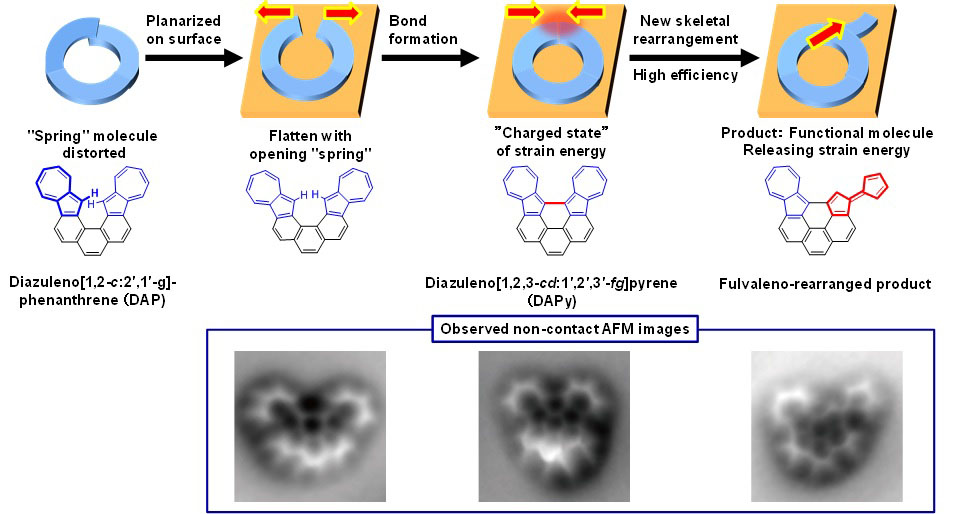ひずみによって誘起される銅表面での多環芳香族炭化水素の骨格転位
Strain-induced skeletal rearrangement of a polycyclic aromatic hydrocarbon on a copper surface
2017年7月20日 Nature Communications 8 : 16089 doi: 10.1038/ncomms16089

有機分子の構造変形を制御すれば、熱的・光学的・電気化学的方法のみでは生み出せない特異な反応を生じさせることができる。しかし、機械化学的方法を含む従来の有機合成では、多環芳香族炭化水素(PAH)の骨格転位を制御するのは難しい。今回我々は、高分解能非接触型原子間力顕微鏡を用いて、金属表面におけるPAHの骨格転位を行う反応スキームを実証している。我々は、有機合成と表面での脱水素環化を組み合わせて、巧みに設計されたPAH(ジアズレノ[1,2,3-cd:1’,2’,3’-fg]ピレン)を作りだした。このPAHは、2つのアズレン部位が互いに接近しているため著しくひずんでいるが,Cu(001)面に平面的に吸着した。この局所ひずみによって、アズレン部位の1つが転位してフルバレン部位へと、これまでに報告されたことがない形式の転位が進行する。今回提案した、ひずみが誘起し熱的に進行する表面合成法は、従来の合成手法では実現できない新種のナノカーボン材料を作製する道を開く。
Akitoshi Shiotari, Takahiro Nakae, Kota Iwata, Shigeki Mori, Tetsuo Okujima, Hidemitsu Uno, Hiroshi Sakaguchi and Yoshiaki Sugimoto
Corresponding Authors
Controlling the structural deformation of organic molecules can drive unique reactions that cannot be induced only by thermal, optical or electrochemical procedures. However, in conventional organic synthesis, including mechanochemical procedures, it is difficult to control skeletal rearrangement in polycyclic aromatic hydrocarbons (PAHs). Here, we demonstrate a reaction scheme for the skeletal rearrangement of PAHs on a metal surface using high-resolution noncontact atomic force microscopy. By a combination of organic synthesis and on-surface cyclodehydrogenation, we produce a well-designed PAH—diazuleno[1,2,3-cd:1′,2′,3′-fg]pyrene—adsorbed flatly onto Cu(001), in which two azuleno moieties are highly strained by their mutual proximity. This local strain drives the rearrangement of one of the azuleno moieties into a fulvaleno moiety, which has never been reported so far. Our proposed thermally driven, strain-induced synthesis on surfaces will pave the way for the production of a new class of nanocarbon materials that conventional synthetic techniques cannot attain.

